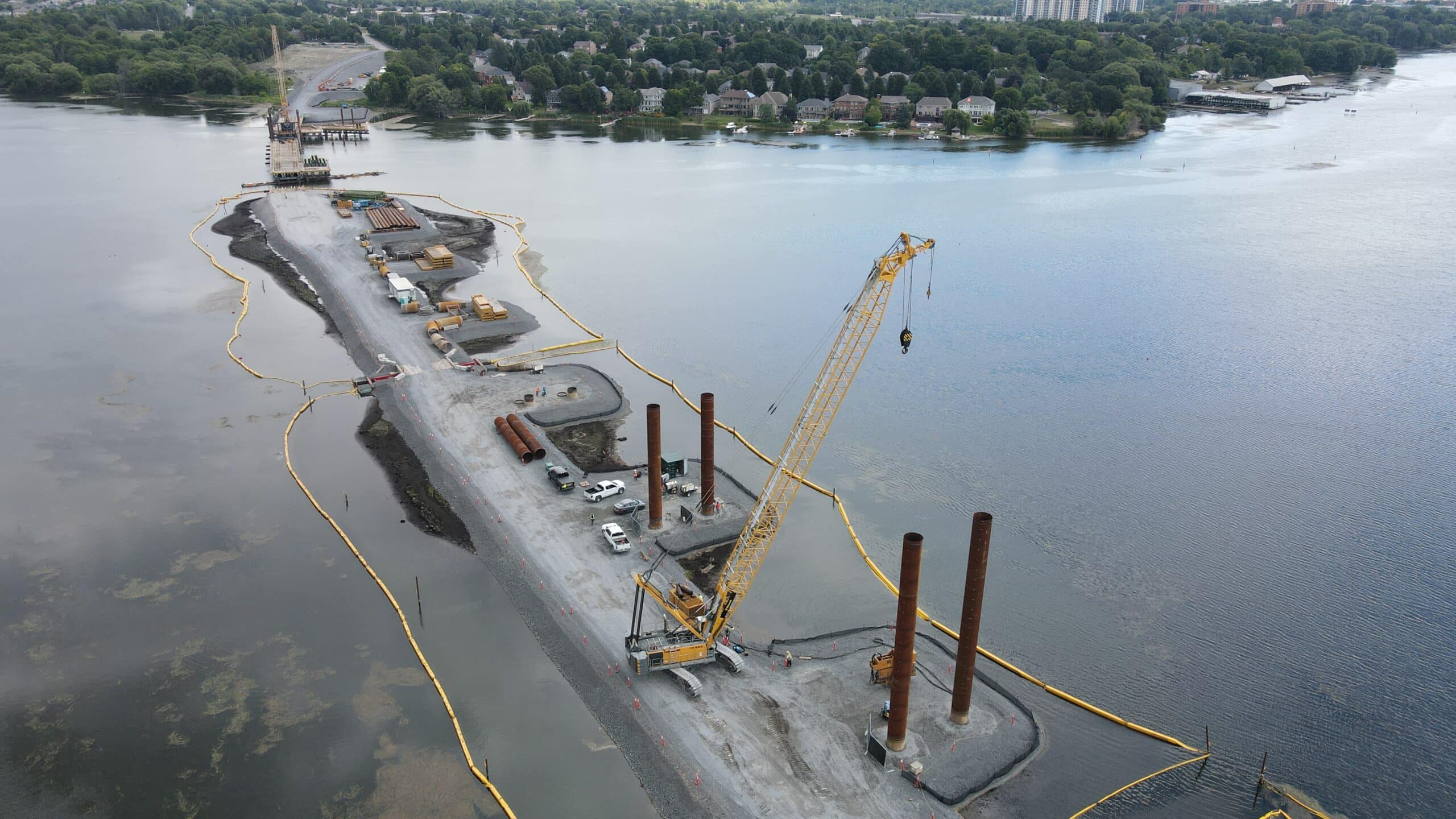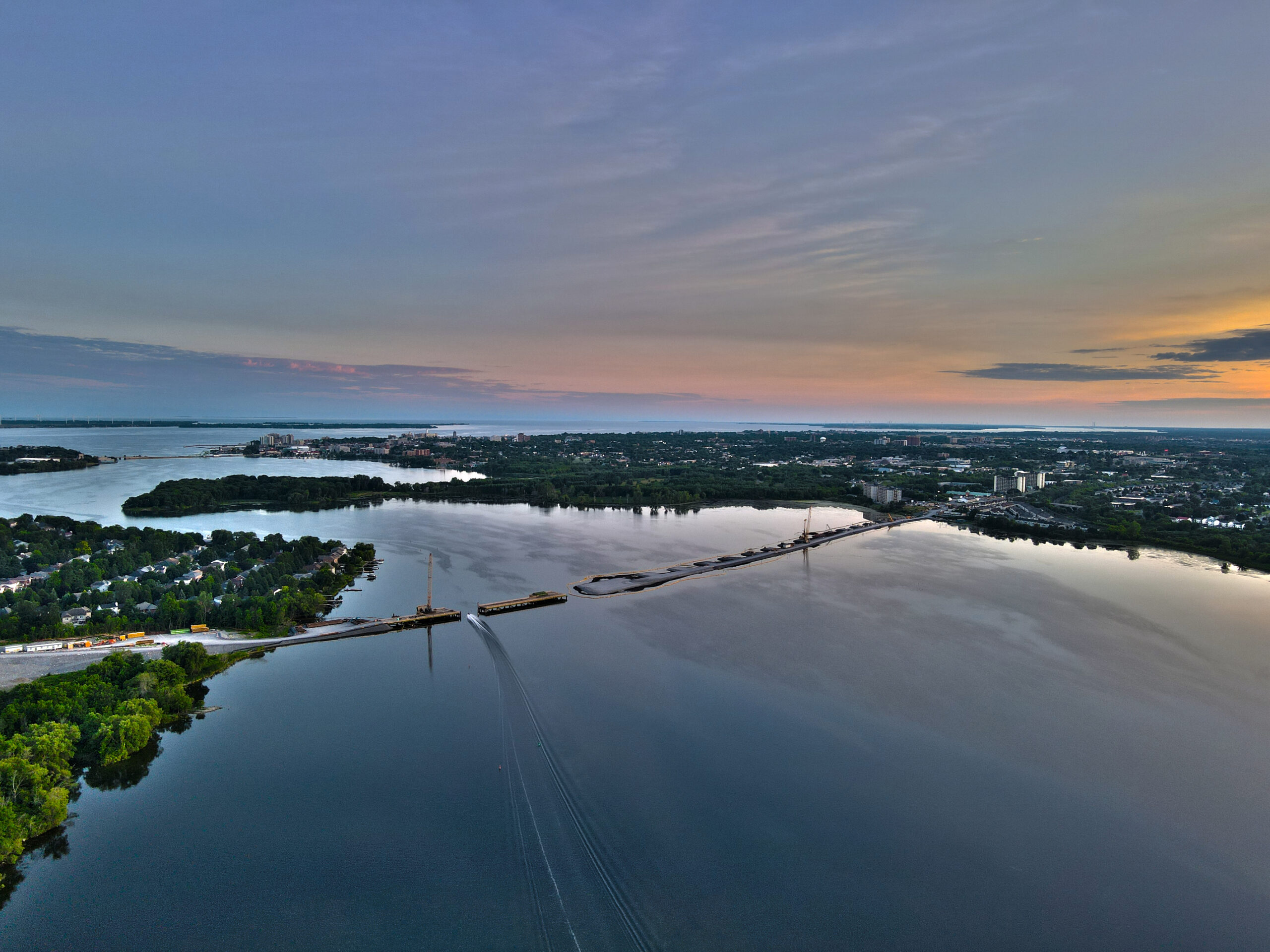The Kingston Third Crossing project is over: the Waaban Crossing Bridge is here! This new Ojibwe language name*, which evokes the dawn and the morning light in the east, was chosen after a survey of local residents. Inhabitants had to opportunity to cross this structure on foot in the preview event on 24 September 2022. As of today the bridge is now open, for both vehicles and soft modes, which benefit from separate lanes. The Waaban Bridge connects the east and west sides of Kingston, separated by the Cataraqui River, which flows nearby into Lake Ontario and forms part of the Rideau Canal, a UNESCO World Heritage Site.
This third bridge over the Cataraqui River is intended to relieve traffic congestion and facilitate the movement of emergency vehicles from one side of the river to the other, while also contributing to the development of active transportation.
*Ojibwe: Algonquian language spoken in the Great Lakes region. It is one of the most widely spoken Amerindian languages.

This third bridge over the Cataraqui River is intended to relieve traffic congestion and facilitate the movement of emergency vehicles from one side of the river to the other, while also contributing to the development of active transportation.

We are proud to have been involved in the design and construction of this major bridge for the people of Kingston and the Lake Ontario region. Over the past five years, we have worked with our partners the City of Kingston, Kiewit and Hatch to ensure that this bridge meets the ambitions of our client and the community.
Zac McGain, project director, SYSTRA IBT
This bridge will make a difference to the lives of residents and will bring Kingston’s two shores closer together. I would like to thank all the teams who have been involved in making this project, the first to be carried out entirely by SYSTRA IBT, a great success!
Edouard Renneville, project manager, SYSTRA IBT

A new form of contract for a pioneering project
This inauguration is the culmination of a construction project that began five years ago and was launched in 2017, just a few months after International Bridges Technologies became part of the SYSTRA Group. One of the particularities of the project is its contractual form: SYSTRA IBT, the engineering firm Hatch and the construction company Kiewit formed an IPD (Integrated Project Delivery) contract with the City of Kingston, an integrated grouping that is a first in North America for linear infrastructure. One challenge is that it is the largest transportation project ever funded in Kingston’s history.
A bridge for the environment
The benefits of this project are also environmental: in addition to the modal shift and the decongestion of road traffic, it has an overall footprint in water that is more than 50% smaller than the initial environmental assessment. Its visual impact on the Rideau Canal UNESCO site has also been reduced, thanks to close dialogue with local stakeholders and the heritage community. The IPD consortium implemented solutions to ensure the navigability of the Rideau Canal between spring and autumn without delaying the work, such as a mixed construction, with a temporary trestle bridge on one side and temporary rock fill on the other to allow for the foundations.
I-beams, known as ‘NU’ in reference to the University of Nebraska, which designed them, were used in the construction. They are prefabricated in pre-stressed concrete and offer greater resistance to flexion-torsion. Finally, it should be noted that the structure delivered to the Kingston authorities exceeds the legal requirements for the design of such a bridge: planned to last 75 years, the Waaban Bridge was designed for a final life of 100 years. This is a great achievement for a project that the authorities welcome as being delivered on time and on budget.

Key facts – Kingston Waaban Bridge
- 2 lanes of road traffic and 1 bi-directional lane dedicated to soft modes, 4 metres wide
- Bridge length: 1.2km, with 800 metres of approach lanes
- Deck width: 15.6m
- Designed to last 100 years
- 95 pre-stressed concrete I-beams, known as NU beams, for the approach crossings
- 1,695 pre-stressed concrete plates to form the deck
- 3,300 tonnes of steel for the main span structure’s framework
- 31,000 tonnes of concrete
- 365,000 tonnes of gravel for the foundations
- Over 29,000 hours of work by local workers
 Australia
Australia  Brazil
Brazil  Canada
Canada  China
China  Denmark
Denmark  France
France  India
India  Indonesia
Indonesia  Ireland
Ireland  Italy
Italy  Malaysia
Malaysia  New Zealand
New Zealand  Norway
Norway  Poland
Poland  Saudi Arabia
Saudi Arabia  Singapore
Singapore  South Korea
South Korea  Sweden
Sweden  Taiwan
Taiwan  Thailand
Thailand  United Kingdom
United Kingdom  United States
United States  Vietnam
Vietnam 





